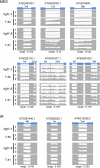Identification of Coilin Mutants in a Screen for Enhanced Expression of an Alternatively Spliced GFP Reporter Gene in Arabidopsis thaliana
- PMID: 27317682
- PMCID: PMC4981272
- DOI: 10.1534/genetics.116.190751
Identification of Coilin Mutants in a Screen for Enhanced Expression of an Alternatively Spliced GFP Reporter Gene in Arabidopsis thaliana
Abstract
Coilin is a marker protein for subnuclear organelles known as Cajal bodies, which are sites of various RNA metabolic processes including the biogenesis of spliceosomal small nuclear ribonucleoprotein particles. Through self-associations and interactions with other proteins and RNA, coilin provides a structural scaffold for Cajal body formation. However, despite a conspicuous presence in Cajal bodies, most coilin is dispersed in the nucleoplasm and expressed in cell types that lack these organelles. The molecular function of coilin, particularly of the substantial nucleoplasmic fraction, remains uncertain. We identified coilin loss-of-function mutations in a genetic screen for mutants showing either reduced or enhanced expression of an alternatively spliced GFP reporter gene in Arabidopsis thaliana The coilin mutants feature enhanced GFP fluorescence and diminished Cajal bodies compared with wild-type plants. The amount of GFP protein is several-fold higher in the coilin mutants owing to elevated GFP transcript levels and more efficient splicing to produce a translatable GFP mRNA. Genome-wide RNA-sequencing data from two distinct coilin mutants revealed a small, shared subset of differentially expressed genes, many encoding stress-related proteins, and, unexpectedly, a trend toward increased splicing efficiency. These results suggest that coilin attenuates splicing and modulates transcription of a select group of genes. The transcriptional and splicing changes observed in coilin mutants are not accompanied by gross phenotypic abnormalities or dramatically altered stress responses, supporting a role for coilin in fine tuning gene expression. Our GFP reporter gene provides a sensitive monitor of coilin activity that will facilitate further investigations into the functions of this enigmatic protein.
Keywords: Arabidopsis thaliana; Cajal body; alternative splicing; coilin; stress.
Copyright © 2016 by the Genetics Society of America.
Figures






References
-
- Austin R. S., Vidaurre D., Stamatiou G., Breit R., Provart N. J., et al. , 2011. Next generation mapping of Arabidopsis genes. Plant J. 67: 715–725. - PubMed
-
- Austin R. S., Chatfield S. P., Desveaux D., Guttman D. S., 2014. Next generation mapping of genetic mutations using bulk population sequencing. Methods Mol. Biol. 1062: 301–315. - PubMed
-
- Bellini M., 2000. Coilin, more than a marker of the Cajal (coiled) body. BioEssays 22: 861–867. - PubMed
Publication types
MeSH terms
Substances
LinkOut - more resources
Full Text Sources
Other Literature Sources
Molecular Biology Databases

